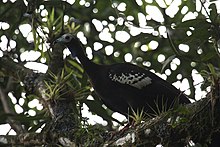
The chachalacas, guans and curassows are birds in the family Cracidae. These are species of tropical and subtropical Central and South America. The range of one species, the plain chachalaca, just reaches southernmost parts of Texas in the United States. Two species, the Trinidad piping guan and the rufous-vented chachalaca occur on the islands of Trinidad and Tobago respectively.

A bird nest is the spot in which a bird lays and incubates its eggs and raises its young. Although the term popularly refers to a specific structure made by the bird itself—such as the grassy cup nest of the American robin or Eurasian blackbird, or the elaborately woven hanging nest of the Montezuma oropendola or the village weaver—that is too restrictive a definition. For some species, a nest is simply a shallow depression made in sand; for others, it is the knot-hole left by a broken branch, a burrow dug into the ground, a chamber drilled into a tree, an enormous rotting pile of vegetation and earth, a shelf made of dried saliva or a mud dome with an entrance tunnel. The smallest bird nests are those of some hummingbirds, tiny cups which can be a mere 2 cm (0.8 in) across and 2–3 cm (0.8–1.2 in) high. At the other extreme, some nest mounds built by the dusky scrubfowl measure more than 11 m (36 ft) in diameter and stand nearly 5 m (16 ft) tall. The study of birds' nests is known as caliology.
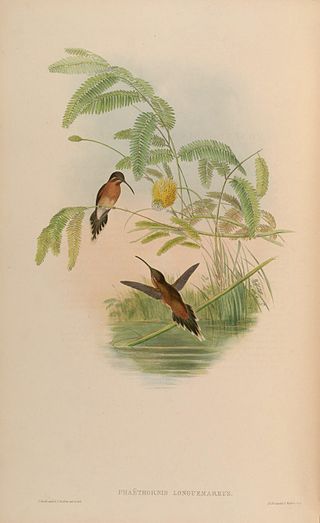
The little hermit is a hummingbird that is a resident breeder in north-eastern Venezuela, northern Guyana, Suriname, French Guiana and Trinidad. This lowland species occurs in various semi-open wooded habitats, e.g. mangrove, secondary forest, plantations and scrub. In Trinidad it also occurs in rainforest. It is fairly common in most of its range, and therefore listed as Least Concern by BirdLife International.
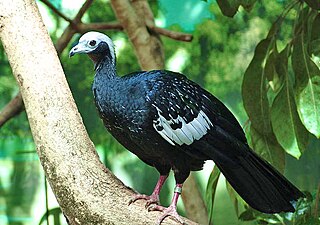
The piping guans are a bird genus, Pipile, in the family Cracidae. A recent study, evaluating mtDNA, osteology and biogeography data concluding that the wattled guan belongs in the same genus as these and is a hypermelanistic piping guan. Thus, Pipile became a junior synonym of Aburria, though this conclusion was not accepted by the South American Checklist Committee, or evaluated by the IOC, so the classification remains in Pipile.

The masked duck is a tiny stiff-tailed duck ranging through the tropical Americas.
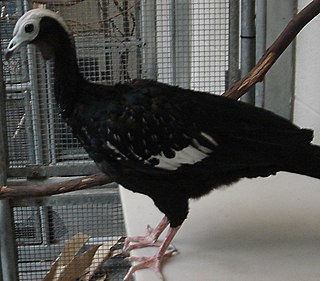
The guans are a number of bird genera which make up the largest group in the family Cracidae. They are found mainly in northern South America, southern Central America, and a few adjacent Caribbean islands. There is also the peculiar horned guan which is not a true guan, but a very distinct and ancient cracid with no close living relatives.

The black-fronted piping guan or jacutinga in Brazilian Portuguese is a bird in the chachalaca, guan, and curassow family Cracidae. It is found in Argentina, Brazil, and Paraguay.
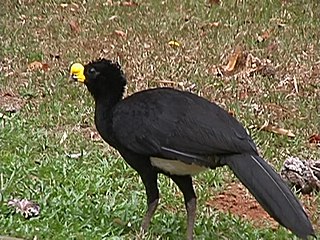
The great curassow is a large, pheasant-like bird from the Neotropical rainforests, its range extending from eastern Mexico, through Central America to western Colombia and northwestern Ecuador. Male birds are black with curly crests and yellow beaks; females come in three colour morphs, barred, rufous and black. These birds form small groups, foraging mainly on the ground for fruits and arthropods, and the occasional small vertebrate, but they roost and nest in trees. This species is monogamous, the male usually building the rather small nest of leaves in which two eggs are laid. This species is threatened by loss of habitat and hunting, and the International Union for Conservation of Nature has rated its conservation status as "vulnerable".
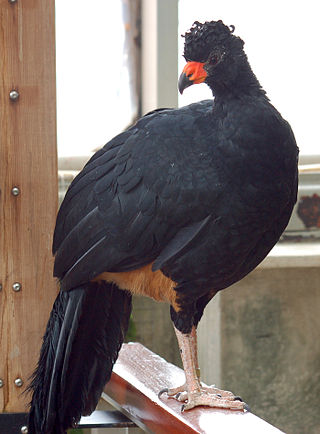
The wattled curassow is a threatened member of the family Cracidae, the curassows, guans, and chachalacas. It is found in remote rainforests in the western Amazon basin in South America. Males have black plumage, except for a white crissum, with curly feathers on the head and red bill ornaments and wattles. Females and juveniles are similar but lack the bill ornamentation and have a reddish-buff crissum area. The wattled curassow is the most ancient lineage of the southern Crax curassows. In captivity, it sometimes hybridises with the blue-billed curassow.
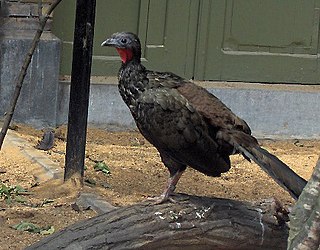
Penelope is a bird genus in the family Cracidae consisting of a number of large turkey-like arboreal species, the typical guans. The range of these species is in forests from southern Mexico to tropical South America. These large birds have predominantly brown plumage and have relatively small heads when compared to the size of their bodies; they also bear a characteristic dewlap. Body lengths are typically 65 to 95 centimeters.

The wattled guan is a species of bird in the family Cracidae. It is a fairly large black cracid with blue-based, black-tipped beak and a long, red-and-yellow wattle.

The black-eared wood quail is a bird species in the order Galliformes. Until recently, the species was thought to be part of the family Phasianidae however DNA-DNA hybridization results determined that black-eared wood quail are only distantly related to Old World quail. As a result, black-eared wood quail have been placed in the family Odontophoridae and more specifically, in the category of wood quail.

The red-throated piping guan is a species of bird in the chachalaca, guan, and curassow family Cracidae. It is found in Bolivia and Brazil.
The white-mantled kingfisher or New Britain kingfisher is a species of bird in the family Alcedinidae. It is endemic to New Britain off Papua New Guinea. Its natural habitat is tropical moist lowland forests.
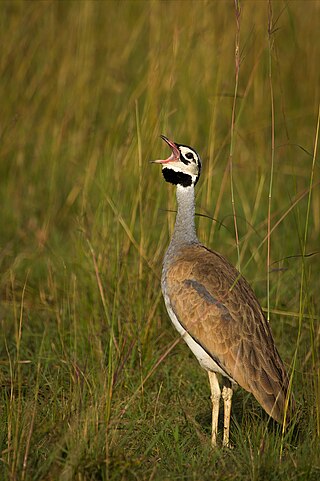
Eupodotis is a genus of bird in the bustard family Otididae. It contains two species, all restricted to Africa. Species in the genera Afrotis and Lophotis are sometimes included in this genus; however some authorities separate the Karoo korhaan, Rüpell's Korhaan and little brown bustard as a separate genus Heterotetrax.

The blue-throated piping guan is a species of bird in subfamily Penelopina of family Cracidae, the guans, chachalacas, and curassows. It is found in Bolivia, Brazil, Colombia, Ecuador, the Guianas, Peru, and Venezuela.

The Yungas guan is a species of bird in the family Cracidae, the chachalacas, guans, and curassows. It is found in the Andean foothills of Argentina and Bolivia.
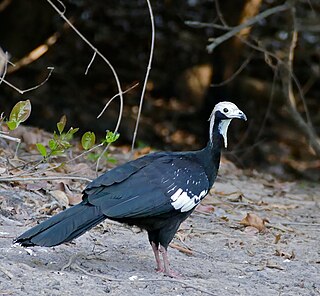
The white-throated piping guan is a near threatened species of bird in subfamily Penelopinae of family Cracidae, the guans, chachalacas, and curassows. It is found in Bolivia, Brazil, Paraguay, and Peru.
